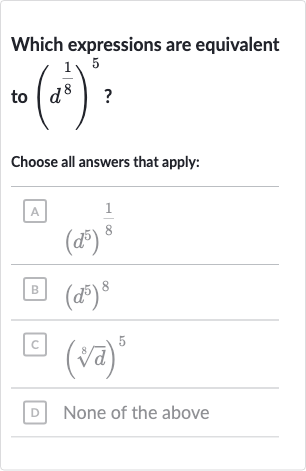Full solution
Q. Which expressions are equivalent to ?Choose all answers that apply:A. B C D None of the above
- Understanding Exponent Properties: Understand the properties of exponents. When raising a power to a power, you multiply the exponents. This is based on the property .
- Applying Exponent Property to the Expression: Apply the exponent property to the given expression.
- Checking Answer Choice A: Check each answer choice to see if it is equivalent to .
A.
This matches our expression from Step , so choice A is equivalent. - Checking Answer Choice B: Check choice B.B. This does not match our expression from Step , so choice B is not equivalent.
- Checking Answer Choice C: Check choice C.C. This matches our expression from Step , so choice C is equivalent.
- Checking Answer Choice D: Check choice D.D. None of the aboveSince we have found that choices A and C are equivalent to the given expression, choice D is not correct.
More problems from Compare linear and exponential growth
QuestionGet tutor help
QuestionGet tutor help
QuestionGet tutor help
QuestionGet tutor help
QuestionGet tutor help
QuestionGet tutor help
QuestionGet tutor help

